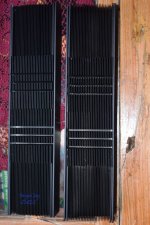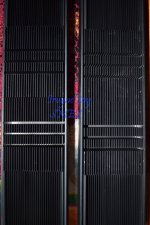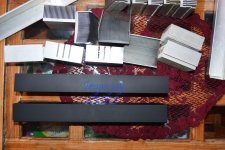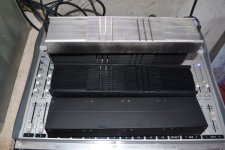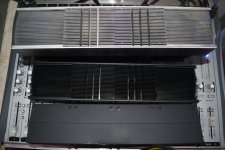Im posting this maybe somebody having problems how to get heatsink for amp project like me im having hard time looking for good heatsink for my projects and i got an idea how to make it simple and low cost it just need time and patience
all material can be found on junk shop or surplus store
1) Socket 478 or AMD heat sink processor (need to be identical and flatten bottom
2)1.5x1.5 inch anodize thick aluminum angle bar
3)Push drill/handrill and drill bits
4)screw
5)hand tap
we can also use riveter but i prepare to use screw its easy to adjust when made mistake
all material can be found on junk shop or surplus store
1) Socket 478 or AMD heat sink processor (need to be identical and flatten bottom
2)1.5x1.5 inch anodize thick aluminum angle bar
3)Push drill/handrill and drill bits
4)screw
5)hand tap
we can also use riveter but i prepare to use screw its easy to adjust when made mistake
Attachments
Last edited:
Excellent idea.
As constructed, they would be placed horizontally inside the case.
If you placed the CPU heatsinks side by side, with the fins vertical, you can mount them on the sides of the cabinet.
Now where can I get me some of those heatsinks?
As constructed, they would be placed horizontally inside the case.
If you placed the CPU heatsinks side by side, with the fins vertical, you can mount them on the sides of the cabinet.
Now where can I get me some of those heatsinks?
A few problems with htis:
These heatsinks are made for forced air flow. Because of this the fins can be spaced very close together. If you use them with natural air flow, use the old pentium style heatsinks with fewer fins and larger spacing. The reason for this is, the close spacing creates vortexes with slow naturally moving air, which keep the air between the fins instead of circulating and carrying away the heat from the fins. However only a small amount of forced air movement (slow fan) will drastically improve the situation.
VERY IMPORTANT - as the air heats up from the heat in the heatsinks, it wants to go upwards. If you put fins horizontally, the fons themselves will prevent this and in fact the heatsink will be VERY inefficient especially taking into account the number of fins and their area. Keep in mind that only the parts of the heatsink with air moving around them are actually taking the heat away - the actuall mass of the heatisnk just acts as a sort of 'heat capacitor' - if not enough air is circulating, the heat will eventually build up/
In other words, if you are counting on natural airflow (no fan), then fins must always go vertically. Your heatsinks as pictured should be vertical for best efficiency, puttink the fins horizontally will reduce effectivenes by a huge factor (10-fold is not uncommon).
These heatsinks are made for forced air flow. Because of this the fins can be spaced very close together. If you use them with natural air flow, use the old pentium style heatsinks with fewer fins and larger spacing. The reason for this is, the close spacing creates vortexes with slow naturally moving air, which keep the air between the fins instead of circulating and carrying away the heat from the fins. However only a small amount of forced air movement (slow fan) will drastically improve the situation.
VERY IMPORTANT - as the air heats up from the heat in the heatsinks, it wants to go upwards. If you put fins horizontally, the fons themselves will prevent this and in fact the heatsink will be VERY inefficient especially taking into account the number of fins and their area. Keep in mind that only the parts of the heatsink with air moving around them are actually taking the heat away - the actuall mass of the heatisnk just acts as a sort of 'heat capacitor' - if not enough air is circulating, the heat will eventually build up/
In other words, if you are counting on natural airflow (no fan), then fins must always go vertically. Your heatsinks as pictured should be vertical for best efficiency, puttink the fins horizontally will reduce effectivenes by a huge factor (10-fold is not uncommon).
- Status
- Not open for further replies.

